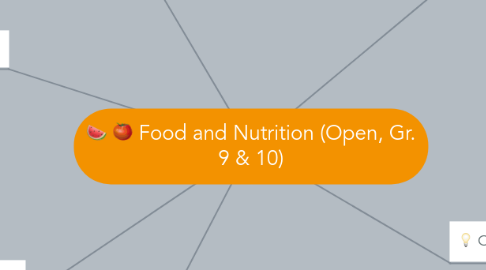
1. Classroom Dynamics
1.1. Most students are from a middle class SES
1.2. 25 students in total; each will be asked to pay $20 for course materials (e.g. food ingredients)
1.2.1. School will compensate for students who are unable to contribute $20 due to financial reasons
1.3. Students are required to score at least 80% on safety test in order to cook or bake on Thursdays
1.4. 12 boys and 13 girls; large range of academic abilities
1.4.1. Accommodations
1.4.1.1. ESL students: paired with peers that can model and assist with learning, groups asked to assign students with ability levelled activities or tasks
1.4.1.2. 1:1 work with students who require extra help
1.4.1.3. Extra time if required
1.4.1.4. Visual examples, copies of instructions (delivered verbally and written)
2. Assessment Activities
2.1. Learning Centres
2.1.1. 1) determine purpose 2) organize with different abilities and interests 3) establish expectations 4) how will learning be evidenced?
2.2. Collage
2.2.1. 1) determine theme options 2) allow students to create problem addressed 3) gather various materials
2.3. Presentation
2.3.1. 1) idea/theme/problem/information 2) student option of type 3) individual or group?
2.4. Cooperative Learning Strategies
2.4.1. Purposeful talk engaging students to explore thinking, respond to ideas, process info and communicate thoughts with peers and teachers
2.5. Note Making
2.5.1. Informal assessment to practice students note making and taking skills
3. Possible Lesson Ideas
3.1. Daily Food Log, Patterns and Food Intake
3.2. Canadian Food Guide (fats, carbs, protein, etc)
3.3. Complete Meal for a Family
3.4. Food Trade/Market Ontario
4. Resources
4.1. Food for Now and in the Future - a food and nutrition strategy for Ontario: Executive summary of a discussion paper by the Ontario Public Health Association Food Security Work Group, March 1995
4.2. Ontario's Food Story: Written and illustrated by Tony Biddle for the Ontario Public Health Association, 1995
4.3. PBS: The Food Machine (53 minutes) Link: http://www.pbs.org/video/2214315175 /
4.4. Suzuki Diaries: The Future City (45 minutes) Link: http://www.cbc.ca/natureofthings/episodes/suzuki-diaries-future-city
4.5. Food Share - Food share is a non-profit organization working with communities and schools to deliver both health food as well as food education. Food Share provides a variety of programs as well as printable resources for educators to use regarding topics from food literacy, to designing community gardens. Link: http://foodshare.net/
4.6. The Food Trade Game The Food Trade Game is an interactive tool designed to educate participants regarding industrial agriculture, small-holder farming, fair trade, and agriculture markets. The game involves role playing as multiple stakeholders in the food system. Link: http://www.foodtradegame.com/#!the-game/zmj7c
5. Ontario Curriculum Standards
5.1. Research and Inquiry Skills - Overall Expectations A1. Exploring: explore topics related to food and nutrition, and formulate questions to guide their research; A2. Investigating: create research plans, and locate and select information relevant to their chosen topics, using appropriate social science research and inquiry methods; A3. Processing Information: assess, record, analyse, and synthesize information gathered through research and inquiry; A4. Communicating and Reflecting: communicate the results of their research and inquiry clearly and effectively, and reflect on and evaluate their research, inquiry, and communication skills.
5.1.1. Organize, interpret, and communicate the results of their inquiries, using a variety of methods (e.g. graphs, diagrams, oral presentations, newspaper articles, hypermedia presentations and videos
5.2. Nutrition and Health - Overall Expectations B1. Canada’s Food Guide: demonstrate an understanding of the nutritional and health recommendations in Canada’s Food Guide; B2. Eating Patterns: demonstrate an understanding of eating patterns that contribute to optimal physical health; B3. Body Image and Attitudes about Food: demonstrate an understanding of factors that contribute to a positive body image and healthy attitudes about food.
5.2.1. B1.4 identify key nutrients, their sources and functions, and the food groups in which they can be found (e.g., carbohydrates in the Grain Products group, protein in the Meat and Alternatives and Milk and Alternatives groups) B1.5 describe people’s nutritional needs at different stages in the lifespan, as outlined in Canada’s Food Guide
